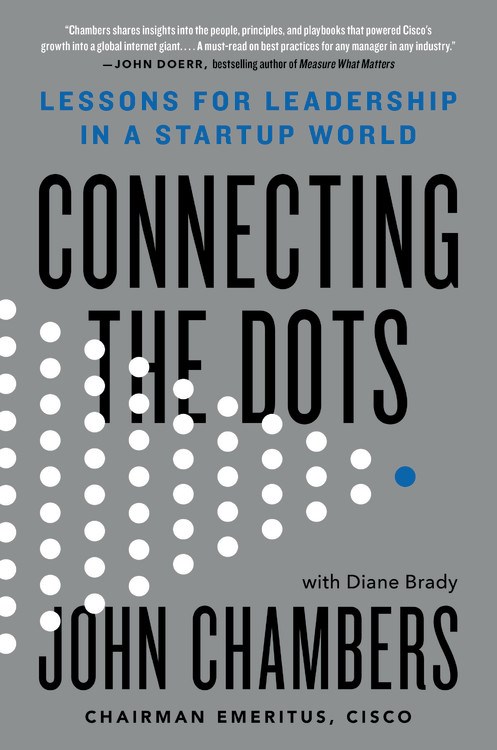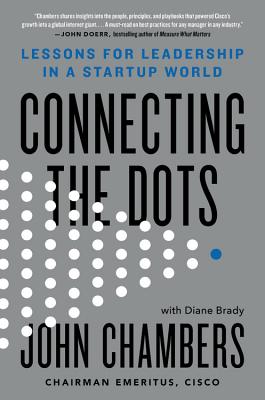Connecting the Dots: Lessons for Leadership in a Startup World
November 05, 2018
In this excerpt, former Cicso CEO John Chambers writes about what to do after disaster strikes, and how setbacks can make you stronger.

In Connecting the Dots, Silicon Valley visionary John Chambers shares the lessons that transformed a dyslexic kid from West Virginia into one of the world's best business leaders and turned a simple router company into a global tech titan.
When Chambers joined Cisco in 1991, it was a company with 400 employees, a single product, and about $70 million in revenue. When he stepped down as CEO in 2015, he left a $47 billion tech giant that was the backbone of the internet and a leader in areas from cybersecurity to data center convergence. Along the way, he had acquired 180 companies and turned more than 10,000 employees into millionaires.
In the excerpt below, he discusses what to do…
After Disaster Strikes (Setbacks Can Make You Stronger)
In my opinion, and it may surprise many of you, I believe that successful leaders are more a product of their setbacks and how they handle them than their successes. All of us will face multiple crises in our lives. Whether it’s a personal crisis or a business issue, the resulting pain can be hard to take. You might feel knocked back, embarrassed, or too overwhelmed to know what to do. How quickly you address the crisis at hand—and I believe you have no choice but to face it head on—could determine whether it hobbles you or helps you come back stronger. I know from personal experience that there are no easy fixes to most problems, and sometimes no fix at all. Loved ones die. Businesses get destroyed. War, crime, natural disaster, illness, bad luck, and numerous other misfortunes can come on like a tsunami and, before you know it, you’re drowning. I’ve been there. In fact, the worst crisis that Cisco ever faced was the result of the dot-com crash of 2001. What I learned from that period became the foundation for a playbook for dealing with setbacks that I’ve used successfully ever since. It might not save you from the next crisis, but it can help you quickly assess what kind of challenge you’re facing and greatly increase your odds of surviving it.o In my opinion, and it may surprise many of you, I believe that successful leaders are more a product of their setbacks and how they handle them than their successes. All of us will face multiple crises in our lives. Whether it’s a personal crisis or a business issue, the resulting pain can be hard to take. You might feel knocked back, embarrassed, or too overwhelmed to know what to do. How quickly you address the crisis at hand—and I believe you have no choice but to face it head on—could determine whether it hobbles you or helps you come back stronger. I know from personal experience that there are no easy fixes to most problems, and sometimes no fix at all. Loved ones die. Businesses get destroyed. War, crime, natural disaster, illness, bad luck, and numerous other misfortunes can come on like a tsunami and, before you know it, you’re drowning. I’ve been there. In fact, the worst crisis that Cisco ever faced was the result of the dot-com crash of 2001. What I learned from that period became the foundation for a playbook for dealing with setbacks that I’ve used successfully ever since. It might not save you from the next crisis, but it can help you quickly assess what kind of challenge you’re facing and greatly increase your odds of surviving it.
One of the biggest mistakes that all of us make, as business leaders and as human beings, is that we personalize every crisis. Faced with a sudden shift in fortunes, we put ourselves at the center of events. It’s happening to us, which means it must be about us. That can lead to a whole truckload of emotions, from anger and denial to a desperate feeling that we have to do something—anything—to turn things around. In this chapter, I want to focus primarily on business crises: the product mishaps, market meltdowns, competitive threats, and many other issues that can derail you on the path to success. How you handle a personal crisis, whether it’s a crisis of your own or one faced by someone on your team, is a different issue that I deal with later in the book. How you shape your message and work with the media during a crisis is also a topic that I think about a lot and will explore in later chapters. For now, let’s focus on the threats that loom over your business. Those are the kinds of issues you have to deal with every day and problems that can quickly escalate into a crisis that kills the business.
Nobody needs be told that lashing out, hiding from reality, and kneejerk reactions rarely result in favorable outcomes. The problem is that most people don’t recognize when they’re doing any of those things in a crisis. They might genuinely believe that they did nothing to cause their problems and go on the defensive, wanting everyone to know that it’s not their fault. Some double down on what’s worked in the past without investigating whether that model still works. Others start to blow things up: laying people off, changing the leadership team, killing new projects, firing suppliers, moving into new areas, and generally disrupting the business for no other reason than the fact that it’s fallen on hard times and something is clearly wrong. If things around them have changed, they assume that means they need to change, too. That instinct can also be a mistake.
The first thing you do in a crisis is stay calm and investigate what’s really going on. It’s what my dad taught me all those years ago when I fell into the Elk River, and it’s been a critical skill throughout my whole career. Moreover, it’s a skill that everyone can learn. Anyone who knows me will tell you that I am not a low-energy guy. I get excited. I jump around onstage. I laugh hard and I hug people and, when I’m immersed in a project, I find it hard to stop. Several colleagues jokingly threatened to boycott meetings at my house if I didn’t lay out food because I’d have us go for 10 to 12 hours without a food break. When a genuine crisis hits, though, I become different: My voice slows down, my demeanor grows calm, and I methodically go through various steps to investigate what’s going on. Like a medical doctor, you’re trying to diagnose the disease from a random collection of symptoms so that you can prescribe the best treatment. Whether you actually feel Zen-like inside isn’t the issue. What matters is your demeanor and state of mind. When you stay calm, the people around you are less likely to panic and the situation you’re dealing with is less likely to spin out of control. I probably don’t have to tell this to anyone who has taken care of kids. Calmness makes it easier to listen and focus on finding the cause of the problem. It’s impossible to stay calm while giving in to emotions like anger, resentment, or fear. The process forces you to step outside yourself and do a deep dive to understand the size and scope of the problem you’re facing before you make a move.
Once again, the key is to stay close to customers. It might seem counterintuitive to share problems with customers when instilling confidence is how you make a sale. It’s not. If you build a trusting and transparent relationship with your customers, you become invested in each other’s success. Data might tell you if a crisis is real but it’s no substitute for connecting with the people who buy your products. They’re your best resource in identifying any underlying issues on your end, and in the market, and can tell what areas you need to fix. If the crisis is due to something beyond your control, customers are often first to sense it. They’re on the front lines, and are more likely to spot shifts in the market or competitive landscape than you are.
Excerpted from Connecting the Dots: Lessons for Leadership in a Startup World.
Published on September 25, 2018 by Hachette Books, a division of Hachette Book Group.
Copyright © 2018 by John Chambers.
All rights reserved.
ABOUT THE AUTHORS
John Chambers, chairman emeritus at Cisco, served as the company’s CEO for more than two decades. He has worked closely with government leaders from around the world, serving on committees for two U.S. presidents and earning the first-ever Clinton Global Citizen Award as well as the Woodrow Wilson Award for Corporate Citizenship. He is also the founder and CEO of JC2 Ventures, where he helps disruptive startups to scale and lead market transitions.
Diane Brady is an award-winning journalist and consultant who has covered the global business landscape for Bloomberg Businessweek, The Wall Street Journal, and other media outlets. Her previous book, Fraternity, was named one of Amazon’s best books of 2012.


